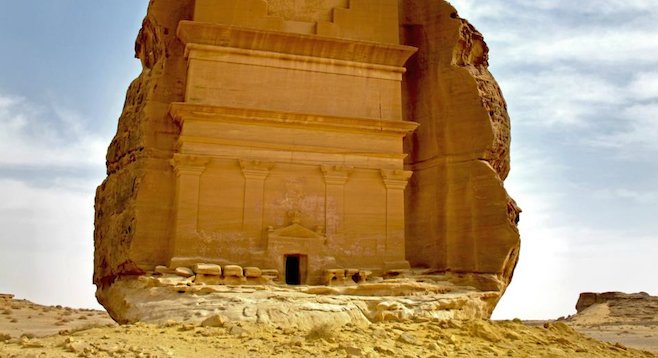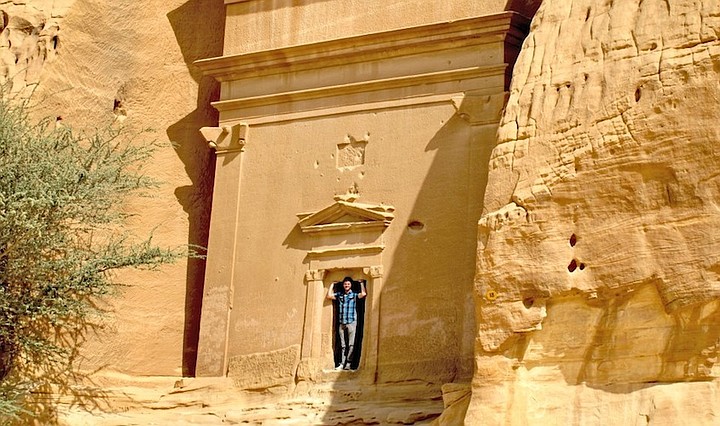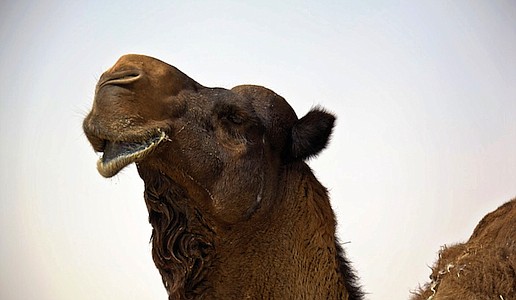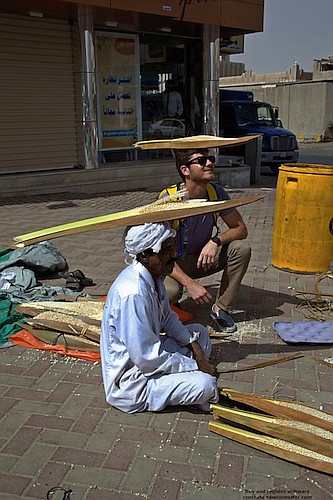 Facebook
Facebook
 X
X
 Instagram
Instagram
 TikTok
TikTok
 Youtube
Youtube

(continued from a March 29 travel story)
Mada’in Saleh: Desert Tombs
On my fourth day in Saudi Arabia, our group took a military plane to visit Mada’in Saleh, a pre-Islamic archaeological site of an ancient civilization whose people created dwellings and tombs by carving full-size rooms out of massive rock outcroppings.
Deplaning after the two-hour flight on a cargo plane used by the Saudi Royal Air Force, my eyes adjusted to the intense brightness outside and settled onto my first sight of Arabian desert skyline. The view was a cross between New Mexico and the moon.
As we drove in an air-conditioned tour bus supplied by a local hotel, we passed rock structures that made the inspiration behind the Sphinx seem obvious. I was seeing faces in mountainsides that had been shaped by millennia of wind erosion.

These natural carvings paled in comparison, however, to the man-made modifications made to the landscape that we saw once inside Mada’in Saleh. Our bus made several stops, allowing us to visit these ancient tombs firsthand. Unfortunately, due to our tight schedule, we were allowed to take only ten minutes per stop.
I ended up causing a delay as I took off and decided to climb to the top of one of these huge outcrops. I couldn’t help myself; I’d been moving at a snail’s pace for the past five days and just needed to raise my heart rate. I felt bad for keeping the group waiting, but was enchanted by the endless vista that spread out before us. It was just a hint of the vast, history-rich landscape that defines this country.
Camp Aramco
The next day the whole group flew on another military aircraft to the Eastern Province, where my family had spent their time in Arabia, and where my father and I would spend the remainder of our trip. Upon landing at the Dammam airport, we were ushered onto yet another tour bus and taken to Dhahran, the headquarters of Saudi Aramco.
The area that makes up Aramco is a heavily guarded camp – a fully functioning entity with schools, hospitals, a firehouse, golf course, tennis courts, a skate park, administrative buildings, chemical research facilities, water treatment stations and everything else needed to operate the world’s largest oil company as well as comfortably sustain its employees. About half of Saudi Aramco’s employees are expatriates, so the camp shows familiar signs of Western culture, including a Little League baseball team.
Driving into camp was like returning to Earth. The camp felt oddly similar to a small Midwestern U.S. town. People were dressed casually in Western clothes; women drove freely and everyone in camp knew everyone else.
Immediately after entering camp, we exited the bus, went into an administrative building and met several Aramco officials. After introducing ourselves and explaining our connection with Aramco, we were given a presentation about the new King Abdulaziz Cultural Center.
It was made clear on this occasion, as well as several others, that Saudi Arabia is seeking to shed the image of an oil-loving Muslim extremist state and adopt an identity of a world leader in culture preservation and celebration.
After lunch, the majority of the group took the bus back to the Dammam airport and then flew back to Riyadh, where they would spend one more day before departing and returning home. Several of us, however, had arranged to stay in Dhahran for several days before returning to the States – my father and I at his best friend’s family’s home. Unfortunately, his best friend, Tom Owen, was going to be out of town for the weekend (observed on Thursday and Friday in Saudi Arabia), so we were left in the care of Tom’s lovely wife, Kathy.
The first full day in the Eastern Province was relatively uneventful compared to the jam-packed schedule we’d kept in Riyadh. Kathy, my father and I spent the morning shopping in downtown Khobar, which is connected to Dhahran by a highway surrounded by modern seaside condominiums.
According to my father, the area between the two towns, a few miles, “used to all be desert,” a claim I would hear over and over again as we discovered that the region I had heard so much about had undergone massive growth. The changes had rendered my father’s home nearly unrecognizable. The area of downtown Khobar where we bought traditional Arab clothing and other gifts had expanded from one street of markets to a maze of carpet and tapestry stores, gold and silver shops and discounted electronics merchants. The abundance of Oriental rugs was particularly astounding.
After shopping and wandering for several hours, the call to prayer sounded, and we headed back to camp along the newly constructed highways.
We had plans to take a drive out into the desert to see some real empty land, but a shamal (winds from the north) had rolled in, carrying a massive dust storm, and visibility was cut down to a few hundred feet. I actually collected sand in my mouth just standing outside for a few minutes.
The evening ended with us visiting several homes and hearing much of the usual topics of conversation: life and work in Saudi Aramco. It seemed that the security of this enclosed camp made it easy to be fully engulfed by life in the fishbowl.
Into the Desert: Wild vs. Man
The following day, Friday, February 17th, we got our trip into the desert. Again, David Owen loaded us up into his 4-wheel drive SUV and we caravanned for nearly two hours southwest into the Abqaiq desert.
We drove down heavily littered roads lined with power lines and oil refineries for hours, just looking for nothingness. Eventually we pulled off the road and headed straight into the empty desert. Soon the road was nowhere in sight, and we’d wound around so many dunes that I no longer had any idea which direction we were facing.
This area of desert was truly vast and, save for massive dunes, featureless. I commented that Bear Grylls could film an episode of Man vs. Wild out here. My Dad suggested he would probably give up in such an unforgiving environment.
Spending some time climbing one of the bigger dunes we came across, I easily saw why my family held such positive feelings about this place. I rarely get the opportunity to feel completely disconnected from human influence living in Southern California, and being in this wide-open space without a hint of human existence reminded me how special a deep connection to nature can be.

On the drive home, we passed several herds of camels along the road that were more than compliant in posing for our cameras. We found it difficult to get a shot of the camels without power lines or piles of garbage in the frame, however. It seemed Saudi Arabia’s massive growth spurt was taking wonder and romance out of the natural beauty that makes this land so special.
Half Moon Bay, Hofuf and the al-Qara Caves
Once we got back to the Owens’ house, Kathy, my dad and I drove out to Half Moon Bay. This body of water in the Arabian Gulf is where my dad, mom, sister, grandfather, grandmother and uncle spent a lot of time. When my father was young, he and his friends would sail out to rocky reefs and spear fish for hours. My grandmother and grandfather honed their sailing skills in this bay and my grandfather’s ashes still swim here. Of all the tales that I’ve heard of Saudi Arabia, the stories involving Half Moon Bay are by far my favorite.
Saturday, February 18th saw Tom back into town, and my dad and I convinced him to take the day off work and show us around, a suggestion to which he happily obliged.
At about 10 a.m. we drove south from Dhahran to the town of Hofuf. Just like the other cities we had visited, Hofuf seemed like a collision of old and new, with ancient buildings standing within feet of massive modern hotels and office buildings.

It was great to have Tom with us; he encouraged my father and me to get personally involved in the surroundings as we wandered a souq. Following Tom’s directions, I found myself behind merchant counters selling spices, balancing bushels of crops on my head and helping carpenters build a brick wall.
After the prayer call sounded we left the Hofuf souq and drove to a camel souq, where we were outnumbered by and large by the great livestock of Arabia. The Saudis at the camel souq were very friendly to us and posed for many pictures with their animals. They were not shy about crowding around our camera viewfinders to see their pictures.
As we struggled to find the route to our next destination, I sat in the back seat making handheld cheese and pita bread sandwiches we’d purchased at a gas station. The trip began to remind me of surf trips with my best friends, when getting lost and dealing with the unexpected hang-ups were half the fun.
We eventually found another friendly motorist who led us to Al Hasa, an oasis abounding with palm trees. In Al Hasa we visited the al-Qara caves, a vast, intricate cave system beneath a mountain outcropping.
Unlike caves I’ve visited in Puerto Rico and California, this cave system was above ground and the mountain that housed the caves was scalable. I was able to climb to the “roof” of the caves and take in the view of the oasis. Rather than your stereotypical two palm trees next to a pool of water, this oasis was huge, and from atop the caves I could see the boundary created by the underwater system that fed acres of lush palm trees in the middle of the desert.
An Arabia Worth Remembering
That night, as I wound down my last night in Arabia, I reflected on all I'd experienced that day, happy to have seen so much of the culture firsthand as opposed to looking on from the inside of a tour bus.
I flew home the next day and tried to remind myself that I hadn't dreamt this experience. I had explored a world that only a fortunate few Westerners ever enter. My stereotypes of militant Saudis were shattered, replaced with fond memories of a gracious, generous people.
I am eternally grateful to Prince Sultan for making this trip possible, to the employees of the SCTA who took exceptional care of all of us on the trip, to Arthur Clark who kept our whole group connected and organized, to Dr. Zahir Othman for contacting my grandmother and being absolutely integral in the organization of this trip, to my father who was finally able to show me his home, and to my grandmother for her wonderful generosity in allowing me to take this trip – one that I will never forget.


(continued from a March 29 travel story)
Mada’in Saleh: Desert Tombs
On my fourth day in Saudi Arabia, our group took a military plane to visit Mada’in Saleh, a pre-Islamic archaeological site of an ancient civilization whose people created dwellings and tombs by carving full-size rooms out of massive rock outcroppings.
Deplaning after the two-hour flight on a cargo plane used by the Saudi Royal Air Force, my eyes adjusted to the intense brightness outside and settled onto my first sight of Arabian desert skyline. The view was a cross between New Mexico and the moon.
As we drove in an air-conditioned tour bus supplied by a local hotel, we passed rock structures that made the inspiration behind the Sphinx seem obvious. I was seeing faces in mountainsides that had been shaped by millennia of wind erosion.

These natural carvings paled in comparison, however, to the man-made modifications made to the landscape that we saw once inside Mada’in Saleh. Our bus made several stops, allowing us to visit these ancient tombs firsthand. Unfortunately, due to our tight schedule, we were allowed to take only ten minutes per stop.
I ended up causing a delay as I took off and decided to climb to the top of one of these huge outcrops. I couldn’t help myself; I’d been moving at a snail’s pace for the past five days and just needed to raise my heart rate. I felt bad for keeping the group waiting, but was enchanted by the endless vista that spread out before us. It was just a hint of the vast, history-rich landscape that defines this country.
Camp Aramco
The next day the whole group flew on another military aircraft to the Eastern Province, where my family had spent their time in Arabia, and where my father and I would spend the remainder of our trip. Upon landing at the Dammam airport, we were ushered onto yet another tour bus and taken to Dhahran, the headquarters of Saudi Aramco.
The area that makes up Aramco is a heavily guarded camp – a fully functioning entity with schools, hospitals, a firehouse, golf course, tennis courts, a skate park, administrative buildings, chemical research facilities, water treatment stations and everything else needed to operate the world’s largest oil company as well as comfortably sustain its employees. About half of Saudi Aramco’s employees are expatriates, so the camp shows familiar signs of Western culture, including a Little League baseball team.
Driving into camp was like returning to Earth. The camp felt oddly similar to a small Midwestern U.S. town. People were dressed casually in Western clothes; women drove freely and everyone in camp knew everyone else.
Immediately after entering camp, we exited the bus, went into an administrative building and met several Aramco officials. After introducing ourselves and explaining our connection with Aramco, we were given a presentation about the new King Abdulaziz Cultural Center.
It was made clear on this occasion, as well as several others, that Saudi Arabia is seeking to shed the image of an oil-loving Muslim extremist state and adopt an identity of a world leader in culture preservation and celebration.
After lunch, the majority of the group took the bus back to the Dammam airport and then flew back to Riyadh, where they would spend one more day before departing and returning home. Several of us, however, had arranged to stay in Dhahran for several days before returning to the States – my father and I at his best friend’s family’s home. Unfortunately, his best friend, Tom Owen, was going to be out of town for the weekend (observed on Thursday and Friday in Saudi Arabia), so we were left in the care of Tom’s lovely wife, Kathy.
The first full day in the Eastern Province was relatively uneventful compared to the jam-packed schedule we’d kept in Riyadh. Kathy, my father and I spent the morning shopping in downtown Khobar, which is connected to Dhahran by a highway surrounded by modern seaside condominiums.
According to my father, the area between the two towns, a few miles, “used to all be desert,” a claim I would hear over and over again as we discovered that the region I had heard so much about had undergone massive growth. The changes had rendered my father’s home nearly unrecognizable. The area of downtown Khobar where we bought traditional Arab clothing and other gifts had expanded from one street of markets to a maze of carpet and tapestry stores, gold and silver shops and discounted electronics merchants. The abundance of Oriental rugs was particularly astounding.
After shopping and wandering for several hours, the call to prayer sounded, and we headed back to camp along the newly constructed highways.
We had plans to take a drive out into the desert to see some real empty land, but a shamal (winds from the north) had rolled in, carrying a massive dust storm, and visibility was cut down to a few hundred feet. I actually collected sand in my mouth just standing outside for a few minutes.
The evening ended with us visiting several homes and hearing much of the usual topics of conversation: life and work in Saudi Aramco. It seemed that the security of this enclosed camp made it easy to be fully engulfed by life in the fishbowl.
Into the Desert: Wild vs. Man
The following day, Friday, February 17th, we got our trip into the desert. Again, David Owen loaded us up into his 4-wheel drive SUV and we caravanned for nearly two hours southwest into the Abqaiq desert.
We drove down heavily littered roads lined with power lines and oil refineries for hours, just looking for nothingness. Eventually we pulled off the road and headed straight into the empty desert. Soon the road was nowhere in sight, and we’d wound around so many dunes that I no longer had any idea which direction we were facing.
This area of desert was truly vast and, save for massive dunes, featureless. I commented that Bear Grylls could film an episode of Man vs. Wild out here. My Dad suggested he would probably give up in such an unforgiving environment.
Spending some time climbing one of the bigger dunes we came across, I easily saw why my family held such positive feelings about this place. I rarely get the opportunity to feel completely disconnected from human influence living in Southern California, and being in this wide-open space without a hint of human existence reminded me how special a deep connection to nature can be.

On the drive home, we passed several herds of camels along the road that were more than compliant in posing for our cameras. We found it difficult to get a shot of the camels without power lines or piles of garbage in the frame, however. It seemed Saudi Arabia’s massive growth spurt was taking wonder and romance out of the natural beauty that makes this land so special.
Half Moon Bay, Hofuf and the al-Qara Caves
Once we got back to the Owens’ house, Kathy, my dad and I drove out to Half Moon Bay. This body of water in the Arabian Gulf is where my dad, mom, sister, grandfather, grandmother and uncle spent a lot of time. When my father was young, he and his friends would sail out to rocky reefs and spear fish for hours. My grandmother and grandfather honed their sailing skills in this bay and my grandfather’s ashes still swim here. Of all the tales that I’ve heard of Saudi Arabia, the stories involving Half Moon Bay are by far my favorite.
Saturday, February 18th saw Tom back into town, and my dad and I convinced him to take the day off work and show us around, a suggestion to which he happily obliged.
At about 10 a.m. we drove south from Dhahran to the town of Hofuf. Just like the other cities we had visited, Hofuf seemed like a collision of old and new, with ancient buildings standing within feet of massive modern hotels and office buildings.

It was great to have Tom with us; he encouraged my father and me to get personally involved in the surroundings as we wandered a souq. Following Tom’s directions, I found myself behind merchant counters selling spices, balancing bushels of crops on my head and helping carpenters build a brick wall.
After the prayer call sounded we left the Hofuf souq and drove to a camel souq, where we were outnumbered by and large by the great livestock of Arabia. The Saudis at the camel souq were very friendly to us and posed for many pictures with their animals. They were not shy about crowding around our camera viewfinders to see their pictures.
As we struggled to find the route to our next destination, I sat in the back seat making handheld cheese and pita bread sandwiches we’d purchased at a gas station. The trip began to remind me of surf trips with my best friends, when getting lost and dealing with the unexpected hang-ups were half the fun.
We eventually found another friendly motorist who led us to Al Hasa, an oasis abounding with palm trees. In Al Hasa we visited the al-Qara caves, a vast, intricate cave system beneath a mountain outcropping.
Unlike caves I’ve visited in Puerto Rico and California, this cave system was above ground and the mountain that housed the caves was scalable. I was able to climb to the “roof” of the caves and take in the view of the oasis. Rather than your stereotypical two palm trees next to a pool of water, this oasis was huge, and from atop the caves I could see the boundary created by the underwater system that fed acres of lush palm trees in the middle of the desert.
An Arabia Worth Remembering
That night, as I wound down my last night in Arabia, I reflected on all I'd experienced that day, happy to have seen so much of the culture firsthand as opposed to looking on from the inside of a tour bus.
I flew home the next day and tried to remind myself that I hadn't dreamt this experience. I had explored a world that only a fortunate few Westerners ever enter. My stereotypes of militant Saudis were shattered, replaced with fond memories of a gracious, generous people.
I am eternally grateful to Prince Sultan for making this trip possible, to the employees of the SCTA who took exceptional care of all of us on the trip, to Arthur Clark who kept our whole group connected and organized, to Dr. Zahir Othman for contacting my grandmother and being absolutely integral in the organization of this trip, to my father who was finally able to show me his home, and to my grandmother for her wonderful generosity in allowing me to take this trip – one that I will never forget.
Comments